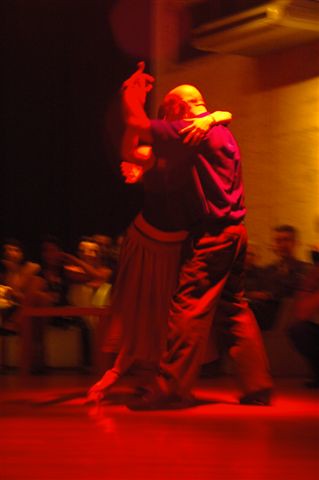
[Photo by Leone Perugino]
Oscar (“Cacho”) Dante
Amsterdam
17 September 1996
Chatting the night away in a cafe in Amsterdam with some friends, I was asked to describe what a milonguero is.
As it happens, it is something very difficult for me to explain. It’s one thing to be one — to feel it — and another, very different, is to be able to express its meaning in words that are clear for others, and give a real idea of what I think. But I will attempt to do it, trying not to hurt anybody’s feelings.
A milonguero is a slave of the music, the tempo, and the space. When he dances, music invades his body and is translated into his steps and his movements. He never misses a tempo. Such blending with the music is what produces a sensation that their bodies are actually speaking (chamuyan).
The milonguero dances level with the floor, managing space is essential for him, he follows the “ronda”. His steps, turns, and walks are always aimed forwards, he never overtakes another couple, he takes care not to cross other people’s path. He will do his thing (milonguea) in whatever space is left. He dances for himself and his partner, not for the spectators. He does not exhibit.
A milonguero stands out by the subtle way in which he manages space, his sense of rhythm and the intensity — or lightness — of the feelings he conveys. The pleasure he feels, he transfers with elegance to the woman’s body. She, in turn, follows him, generally with eyes closed. She follows like the perfume he is wearing, she sticks together in this joyful journey. She dances apilada to him — but not like “cannonball necklace.” Apilarse doesn’t mean hang — this is not always visible for others, but he can certainly feel it.
A milonguero is inspired by the orchestra, the piece, or the woman. He also allows his emotional states to influence the dance. Before beginning a dance, he will take the woman in his arms, listen to the music, feel their respiration, their heartbeats, and only then will he take the first step.
Fortunately, each milonguero dances distinctively. Their personality, style, and cadence are unique to each one. There is plenty of variety among them, with a rich diversity of steps and dance experience. Although they sometimes give in to admiration, their priority is always the woman and the sentimiento (feelings — the main motivation for the dance). They are anonymous. Sometimes timid, and very concentrated. They do not dance much, they are demanding when choosing the music and the partner. One or two tandas well danced will make the evening.
A milonguero will dress very smart, he will be very careful with the shining of his shoes, the crease of his trousers and [his] perfume. You’ll see them sitting at the table checking out the floor and the minas ; they only ask for a dance with a head movement (“de cabeceo”) or an eye movement (“de ojito”). Meanwhile, there are also the milongueras — many, and very good. They are ageless. Their posture, the charm of their footstep, and the subtleties of their movements make for the man’s inspiration, and it’s them who make the man shine. They are simply chiche bombon!!!
I believe it makes no sense to claim that someone is number one or the best, or that one owns a step, or to say that others have stolen somebody’s step. We’ve all learned from the rest and adapted what we learned to our personality. And we will continue to learn from each other in a never-ending process. That is how we enrich our dance, the tango. The tango, like feelings, doesn’t have and never had an owner.
Dancing (milonguear) as well as learning to dance, should be a joy, not an exigency, competition, or hard work; there is enough of that already in our every day life. Our duty and responsibility as teachers does not consist in overwhelming our students with our skills and knowledge, but to be able to communicate these with sentimiento (feelings) and simplicity. We must therefore avoid mistaking our dancing or performing abilities with our teaching abilities. It’s essential, not only [to] count the number of students we have — which is certainly important financially speaking — but also to make an honest balance and observe how many of our students are milongueando in the salons. We must be sincere with ourselves if we wish to see the tango grow.
I wish to express my humble gratitude for entrusting me, for all the students in all the places I have visited as a teacher. Also to their teachers (including all styles and nationalities), for their passion in promoting Tango, and who have not permitted that I feel alone anywhere I go, even if I do not speak their language or ignore their customs. The Tango in all the tango corners of the world I have visited makes me feel at home wherever I go. Bailando tangos uno nunca esta sólo.
This article was originally published in “La Cadena”, a tango magazine in Holland; “El Once” in London and “Tandoneon” in Madrid.
